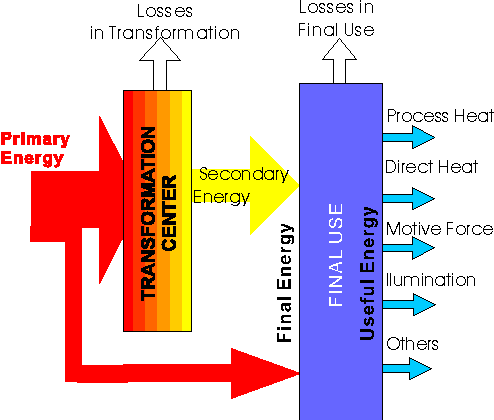
Diagram showing the transformation of primary energy (e.g. coal or wind) to secondary energy (e.g. electricity)
and final use in heating, lighting, motors etc.
It can be difficult to transmit primary energy in its natural form. Primary energies are converted in energy transformation processes to more convenient carriers of energy: secondary energy. Electricity is the most common example, being produced from coal, oil, natural gas, wind, hydro,
etc, in an electricity power station. The convenience of electricity as an energy carrier has resulted in our developing an extensive “grid” to distribute electricity from centralised generating stations. The use of renewable energy has promoted a more distributed, or dispersed, generation of energy, so transformation of primary energy into secondary energy that can be relatively easily distributed is demanding more sophisticated distribution systems.
Electricity can be transported, but storing it is not so convenient. Liquid fuels, in contrast, are easily stored and transported. Crude oil can be refined into the range of fuels we are familiar with: diesel, petrol, etc. They can be converted into thermal energy e.g. heating our buildings, or be further converted into mechanical energy, e.g. transportation. However, we must remember that refining and transportation themselves consume energy.
As we will see later, an industry may convert electricity or fuel into another energy carrier such as compressed air or steam. Final users of energy may use either primary or secondary energy for purposes such as process heating, providing motion, lighting, etc.
Created with the Personal Edition of HelpNDoc: Easily create Help documents